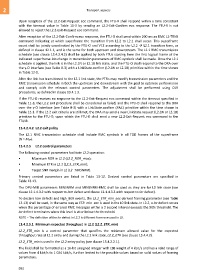Page 1002 - 5G Basics - Core Network Aspects
P. 1002
2 Transport aspects
Upon reception of the L2.2-Exit-Request eoc command, the FTU-R shall respond within a time consistent
with the timeout value in Table 11-3 by sending an L2.2-Exit-Confirm eoc response. The FTU-R is not
allowed to reject the L2.2-Exit-Request eoc command.
After reception of the L2.2-Exit-Confirm eoc response, the FTU-O shall send within 200 ms an RMC L2-TRNS
command indicating at which superframe the transition from L2.2 to L2.1 shall occur. This superframe
count shall be jointly coordinated by the FTU-O and VCE according to the L2.2 L2.1 transition time, as
defined in clause 12.1.1, and is the same for both upstream and downstream. The L2.1 RMC transmission
schedule (see clause 13.4.2.4.2) shall be applied by both FTUs starting from the first logical frame of the
indicated superframe. No change in transmission parameters of RMC symbols shall be made. Once the L2.1
schedule is applied, the link is in the L2.1N or L2.1B link state, and the FTU-O shall respond to the DRA over
the γ-O interface (see Table 8-3) with a LinkState.confirm (L2.1N or L2.1B) primitive within the time shown
in Table 12-1.
After the link has transitioned to the L2.1 link state, the FTUs may modify transmission parameters and the
RMC transmission schedule in both the upstream and downstream with the goal to optimize performance
and comply with the relevant control parameters. The adjustment shall be performed using OLR
procedures, as defined in clause 13.4.1.3.
If the FTU-O receives no response to the L2.2-Exit-Request eoc command within the timeout specified in
Table 11-3, the L2.2 exit procedure shall be considered as failed, and the FTU-O shall respond to the DRA
over the γ-O interface (see Table 8-3) with a LinkState.confirm (FAIL) primitive within the time shown in
Table 12-1. If the L2.2 exit criteria are still met, the DRA may send a new LinkState.request (L2.1N or L2.1B)
primitive to the FTU-O, upon which the FTU-O shall send a new L2.2-Exit-Request eoc command to the
FTU-R.
13.4.2.4.2 L2.2 exit policy
The L2.1 RMC transmission schedule shall include RMC symbols in all TDD frames of the superframe
(N = MSF).
13.4.2.5 L2.2 control parameters
The following control parameters facilitate L2.2 operation:
• Maximum NDR in L2.2 (L2.2_NDR_max);
• Minimum ETR in L2.2 (L2.2_ETR_min);
• Target SNR margin in L2 (L2_TARSNRM).
Primary control parameters are listed in Table 13-12. Derived control parameters are specified in
Table 13-13.
The DPU-MIB parameters MINSNRM and MINSNRM-RMC shall be used as they are for L0 link state (see
clause 12.1.4.3.2 with respect to lom defect and clause 12.1.4.3.3 with respect to lor defect).
To declare lom defects and high_BER events, the L2.2_ETR_min_eoc derived framing parameter (see Table
13-13) shall be used, in the same way as ETR_min_eoc is used in the L0 link state. In L2.2, a lor defect occurs
when the percentage of errored RMC messages within a 2 second interval exceeds the 50% threshold. The
lor defect terminates when this level is at or below the threshold.
NOTE – The definition of the lor defect in L2.2 is different from one used in L0.
13.4.2.5.1 Minimum expected throughput in L2.2 (L2.2_ETR_min)
L2.2_ETR_min is a control parameter that specifies the minimum allowed value for the expected
throughput rate at L2.2 entry and during the L2.2 link state, L2.2_ETR (see clause 13.4.4.2).
L2.2_ETR_min is used in the L2.2 entry policy (see clause 13.4.2.2.1).
The field shall be formatted as a 16-bit unsigned integer with LSB weight of 4 kbit/s and has a valid range of
values from 4 kbit/s to 1 024 kbit/s, further limited to the possible values based on valid values of framing
parameters.
992

